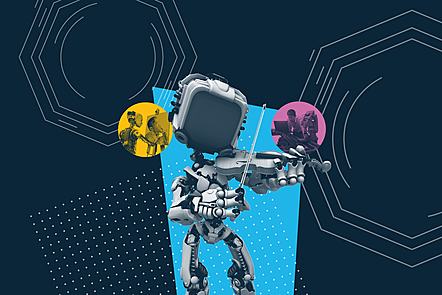What is big data, and how can it help my business?
We explore what big data is and how businesses of all sizes can use analytics techniques to understand their customers and identify trends.

We live in a world where we’re producing data at ever-increasing rates. Every digital device seems to be churning out information about its users, meaning we’re creating an estimated 1.7MB of data per person on Earth every second. This nearly exponential rate of growth means that almost 90% of all data in existence has been created in the last two years. We take a look at how this concept of Big Data fits into the world of business.
As well as exploring what the term actually means, we’ll also examine the different types of big data and how it can be used. We’ll take a look at why it’s so important, and how you can use it to help your business.
What is big data?
The term ‘big data’ seems to be one of the buzzwords of the moment. Yet finding an accurate and up-to-date definition appears to be a difficult task. A 2001 definition from technology researches Gartner defined it big data as, ‘data that contains greater variety arriving in increasing volumes and with ever-higher velocity’.
A 2016 paper proposed a slightly different definition, that big data is ‘the Information asset characterized by such a High Volume, Velocity and Variety to require specific Technology and Analytical Methods for its transformation into Value.’
Both definitions are on the technical side, but there is common ground between them. In layman’s terms, big data refers to large, complex sets of structured and unstructured data. These sets of data are usually so sizeable that specialist software and technology is needed to process them.
The field of big data refers to the entire processes and tools that are used to gather, analyse, utilise, and manage these large sets of data.
The three Vs of data
You’ll notice that both of the first two definitions refer to the volume, velocity, and variety of data. It’s worth highlighting what these three Vs mean, as they form a cornerstone of the big data industry:
- Volume. As you might expect, this refers to the amount of data that needs to be processed. Often, this is unstructured data, meaning it’s not organised in a pre-defined way. When we think of big data, we think in terms of terabytes and petabytes.
- Velocity. This refers to the speed at which the data is received. Some sources, for example, deliver data in real-time or close to it, meaning it needs to be evaluated as such.
- Variety. This term refers to how many different types of data are available. Unstructured data often has a mix of things like text, audio, and video.
Data experts Oracle also highlight that value and veracity are also essential to big data. Value refers to whether the use for the data is discovered, while veracity refers to how accurate it is. Other experts suggest that variability, the ways in which the data can be formatted and used, is also essential.
-

 UAL Creative Computing Institute Apply Creative Machine LearningIT & Computer Science
UAL Creative Computing Institute Apply Creative Machine LearningIT & Computer Science -

 Taipei Medical University AI and Big Data in Global Health ImprovementHealthcare & Medicine,IT & Computer Science
Taipei Medical University AI and Big Data in Global Health ImprovementHealthcare & Medicine,IT & Computer Science
What is big data used for?
The possibilities for the application of big data are vast. What’s more, we’re already seeing a variety of industries make use of the technology for all kinds of purposes. The insights gained often help to make products and services more efficient, relevant, and adaptable for those using them. Some of the uses of big data include:
Understanding customers
We’ll cover this point in more detail further down. However, this is one of the most popular applications of big data. Companies analyse huge swathes of data to understand how their customers behave and what their preferences are. This, in turn, allows them to predict the products that they want to see, as well as to target customers with more relevant and personalised marketing.
A useful example is the music streaming service Spotify. The company uses both artificial intelligence and machine learning algorithms to encourage users to keep interacting with the service. As you listen to and save songs, Spotify identifies similar songs to develop a ‘tastes profile’. From here, it finds and recommends songs that fit your profile but that you haven’t listened to.
Spotting security issues
As digital systems become more complex, there is more scope for things like data breaches and fraud. Big data can be used to analyse trends and identify potential security risks. A good example is in the banking sector, where predictive analytics are used to spot illegal trading and fraudulent transactions. By understanding the ‘usual’ trends, banks can then more easily highlight activity that is out of the ordinary.
Improving healthcare
As a recent Journal of Big Data article highlights, ‘hospital records, medical records of patients, results of medical examinations, and devices that are a part of the Internet of Things’ all generate huge amounts of data. With the proper management and analysis, this big data in the healthcare industry can have many uses.
In some hospitals, data from patients’ smartphones are used to create personalised and evidence-based medical plans for those who are sick. This is possible thanks to the data collected from millions of patients to identify trends in healthcare information.
Improving education
The move towards digital education has accelerated in recent months. Yet even before that, schools, colleges, universities and other education institutions were producing massive amounts of data. This data can be analysed to assess how effective learning material and teachers are, as well as how different students respond to them.
For example, there are software and assessment tools that can monitor student actions when they’re answering questions. Seeing real-time data means teachers can understand both individual students’ needs, as well as wider trends. This means they can create an optimal learning environment for learners.
What are the different types of big data?
To understand how big data can be used to help your business, we first must look at the different types of data and how it’s classified. Doing so is useful as the different types of data affect what you can do with it and the insights you can gain. It’s a detailed topic, but we’ll try and keep it as top-level as possible.
There are three different types of big data; structured, unstructured, and semi-structured. Let’s take a more detailed look at what each of these terms means:
Structured data
This is often the easiest type of data to work with, as it’s highly organised and formatted. Things like spreadsheets and databases with relational keys are usually structured. They’re easy to collect, sort, process and analyse.
Unstructured data
Unstructured data is often more qualitative data that is harder to organise. It could include things like audio, video, social media posts, imagery and more. As such, it’s harder to sort and process, as there isn’t a predefined way of structuring it. Usually, it requires complex algorithms to scan, interpret, and contextualise large sets of unstructured data.
Semi-structured data
As you might expect, this term is used to refer to data that’s somewhere between structured and unstructured. A good example is something like a picture you take on your phone. The image itself is hard to contextualise, but your phone also captures things like the time, date, and location of the image, which is easier to analyse.
The importance of big data in business
Big data is becoming increasingly essential to businesses of all kinds. The insights and information it provides can be invaluable for growing and developing companies, products, and services. Here are some of the ways in which organisations are utilising the concept:
To spot current trends
With the rise of technology like the internet of things (the connection of everyday devices to each other and the internet), we are producing more data than ever before. With this endless stream of information, it becomes far easier for organisations to spot current trends in the market. This knowledge can then be applied to a wide variety of business decisions and processes.
To predict future trends
The field of predictive analytics has grown significantly in recent years. By taking historical data, it’s possible to create a mathematical model that highlights notable trends. This information can then be used on existing data to predict what will happen next. When combined with a big data approach, it can even measure and predict human behaviour. This type of strategy can help businesses plan things like demand for products and financial outcomes.
To make informed decisions
The data that businesses collect and process have many uses. By applying some data science to the information, organisations can make data-driven decisions. Big data can be used to create and apply statistical models that simulate complex functions and solve a broad range of problems.
To gain customer insight
When it comes to understanding how customers interact with a business and marketplace, big data can prove to be invaluable. Through a wide variety of methods, companies can produce a range of customer insights into the demographics, attitudes, behaviours, and habits of their customers.
How can big data help my business?
So, now that we know a little about what big data is and how it can be used in general terms, let’s look at some more specifics. Big data can help all kinds of businesses with a wide variety of projects and challenges.
Creating customer personas
In our series on how to start a business, we explored the concept of customer personas. Essentially, these are a series of templates that help you define your ideal customers. With these personas, you can then improve your marketing, segmentation, and targeting.
You can create customer personas with both qualitative and quantitative data, and the more you have, the more detailed they’ll be. With this information, you can identify aspects such as behavioural drivers, customer mindset, and the obstacles to purchasing. You can also uncover how customers generally find you, as well as how they interact with you online.
Identifying your best customers
As well as highlighting who your potential customers are, big data can also help you to identify your current best customers and what’s important to them. You may assume that those who spend the most with you are your top customers or clients. However, a more detailed set of data could show that these customers are expensive to acquire and purchase from you infrequently.
The more high-quality data you can access, the more insight you gain from it. For example, you can look at factors such as average purchase size, acquisition and retention cost, and overall customer satisfaction.
Informing marketing strategies
Historically, a marketing misstep could cost a business massively. If a campaign fails to resonate with the target demographic, it can spell disaster. Yet with access to more detailed data, marketing becomes a more secure and sophisticated process.
Not only can you get analytics on how people, in general, are responding to your advertising, but you can also run more personalized campaigns. This greater level of focus means that marketing activity can have a clearer strategy, as well as being more effective and costing less.
Managing risk
When it comes to investing and expansion, risk is a natural part of the process. However, being able to identify and manage that risk and make informed decisions is possible through big data. The variety of tools available means that businesses can now quantify and model the risks they face.
Developing new products
Another area in which big data can help your business is through innovation and development. Access to such a diverse range of information means that unique opportunities become more evident, as does the ability to identify what customers are looking for. This, in turn, makes it easier to plan, develop, and manage new products.
Improving processes
The insights available from big data don’t just apply to customers. They can also help your business improve a variety of processes, making things like supply chains more efficient and effective. Organisations can gain real-time information about challenges and opportunities in their current operations, making it easier to improve matters.
-

 Darden School of Business, University of Virginia Digital Product ManagementBusiness & Management,IT & Computer Science
Darden School of Business, University of Virginia Digital Product ManagementBusiness & Management,IT & Computer Science
What are the challenges of using big data?
From everything we’ve explored about the subject so far, it’s clear there’s huge potential for utilising big data. Businesses across all kinds of sectors can benefit from the available insight. However, it’s not all plain sailing. There are several challenges associated with this method of analytics:
The cost
Entering the world of big data has several costs associated with it. There are a few factors worth considering here:
- The hardware and software. As well as systems to manage large volumes of data (such as Hadoop and Apache Spark), you also have to think about storing the data (with systems like Cassandra or HBase).
- The personnel. Data science is a growing field, and those with an understanding of it are in high demand. Salaries for new hires or freelancers can be expensive.
- The development. Developing a big data solution specific to your business can take a fair amount of time and resources.
The knowledge
In this article, we’ve summed up some of the basics of big data and how it can help your business. However, the actual application requires a detailed understanding of data science. Taking a data science course can help you grasp some of the basics, but the application of that knowledge is often complex and multifaceted.
The quality of data
The chances are that you’ll be able to start integrating data streams from a wide variety of sources and in many different formats. The challenge is then to identify which is useful and reliable, as well as how to process that information in a meaningful way. Again, part of the field of big data is focused on this ‘cleansing’ of data, but that doesn’t mean it isn’t challenging.
The security
By collecting such a vast amount of data, there arises the issue of keeping that information safe. Cybersecurity is another hot topic at the moment, as issues of data privacy and GDPR become increasingly important.
What does the future hold for big data?
Although a relatively new field, the significance of global data is seemingly only going to increase. Big data is here to stay, and it’s intriguing to think about what the future holds. Although it’s impossible to say exactly what will happen, it’s highly likely that we’ll continue to create ever-increasing amounts of data.
With more devices joining the Internet of Things, this means we’ll be able to gather more detailed insights about a broader range of topics. Along with this increase in data and insights, we’ll likely need more sophisticated methods of processing and analysing them. As such, fields like artificial intelligence and machine learning will continue to grow alongside big data. Whatever the future holds, it’s going to be fascinating.
-

 Griffith University Big Data Analytics: Opportunities, Challenges and the FutureBusiness & Management
Griffith University Big Data Analytics: Opportunities, Challenges and the FutureBusiness & Management




